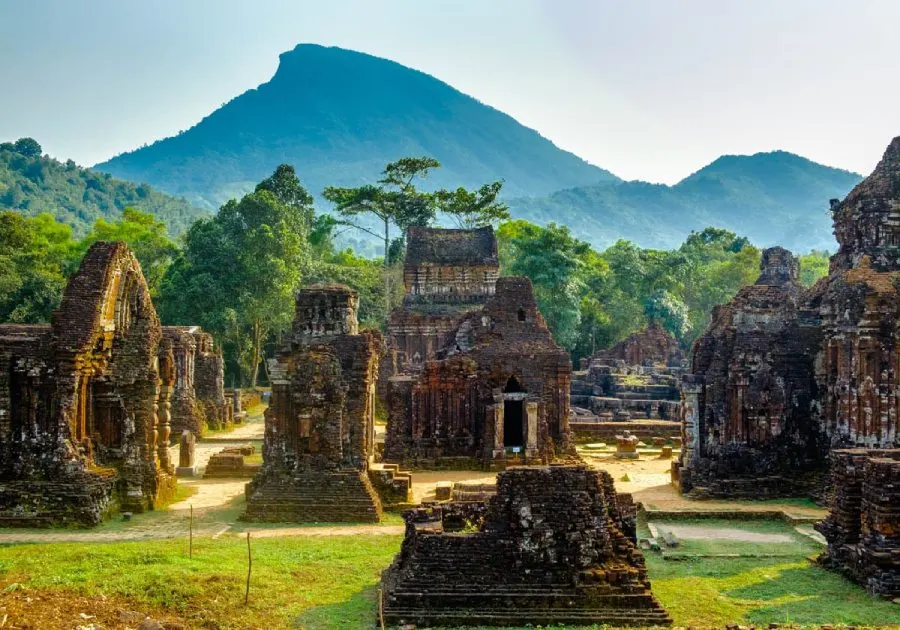My Son Vietnam is a world cultural heritage, the prize that UNESCO uses to recognize cultural value of the site. Mỹ Sơn is pronounced /mee suhn/, not /mai sʌn/
I’ve gone to the sanctuary in the fall 2013, together with my wife in a 3 days vacation in Da Nang and Quang Nam. It’s nearly 70 kilometers from Da Nang. Yet, we didn’t regret spending a few hours riding motorbike to get there.
The region was full of forest trees. I was wondering where the famous area was until the minute we reached the site.

My Son architecture
I was totally impressed by the unique architecture of the tower temples. They were built mostly with bricks that well arranged on one another. The locals say that there was no cement at the time of building back in the 7-9th centuries. Builders used special adhesive material to stick individual bricks together.
The reservation including temples, towers, and epitaph classified into a few groups marked from A to K. Each has instruction and guide, but I just can’t remember in detail. Though scenes are gorgeous, all areas have similar looking: they’re really ruins.
The shapes of the temples reflect the culture and architecture of Cham people, who are affected by Hinduism of the Indian sub-continent. It looks beautiful and really different with what I saw in religious constructions in the North Vietnam.
According to UNESCO, “The authenticity of My Son in terms of design, materials, workmanship, and setting continues to support it Outstanding Universal Value.”
Many tourists say that, though at a smaller scale and less impressive, My Son Vietnam’s architecture is similar to that of Angkor Wat in Cambodia and Bagan in Myanmar. Well, I long to visit the later two to see whether the comment is true.
History of the sanctuary
As per what I listened to a guard who told us stories at site, in addition with what I collected from reading material, here’s a brief history of the landmark.
My Son used to be the religious and intellectual center of Kingdom of Champa since 4th century. It may also be the burial place for royal members or the state’s heroes.
From perspective of eastern philosophy, My Son together with Hoi An (commercial center) and Tra Kieu (political capital) made an advantageous feng shui for the kingdom.
After Champa (Chiêm Thành in Vietnamese) was conquered by Dai Viet in the late 15th century, My Son gradually was fallen into status of being forgotten, damaged, and covered up by dense forest.
In the end of 18th century, a French scholar, C. Paris, re-discovered the ruins. Later on, French scholars continued helping to restore it part by part.
The temples in the sanctuary were further damaged due to time affection and by carpet-bombing by the US air force in Vietnam War in the 1960s.
When I visited there, several temples are still in restoration progress, a project sponsored by UNESCO and Italian government.
At the time of writing article in June 2013, I read an article about My Son on UNESCO website. After 16 years of excavation and restoration work, a group of tower temples and monuments belonging to the My Son Sanctuary, were inaugurated by the Director-General with Vietnamese authorities and the Ambassador of Italy to Viet Nam on 22 June.
As of January 2025, My Son Sanctuary continues to be a focal point for cultural heritage preservation. The site, recognized as a UNESCO World Heritage Site since December 1999, encompasses over 70 structures built between the 4th and 13th centuries CE. Recent archaeological explorations have been initiated to further uncover and preserve this significant site, with ongoing restoration projects aimed at stabilizing the remaining structures and enhancing visitor experiences. Notably, a joint restoration project involving Vietnamese and Indian experts has yielded substantial findings, including numerous artifacts that contribute to our understanding of Cham culture and architecture
If you have a chance to visit My Son Vietnam, I believe you will love it, and Vietnamese various cultures as well. What’s about other people’s thinking about the sanctuary?
Here’re brief of pros and cons in connection to this monument. I just read and summarize comments from travel websites e.g. Tripadvisor.com for your reference.
Pros
- Beautifully architectured buildings and the surrounding mountainous jungle.
- What an amazing part of history to see these ruins is just fantastic
- The heart of the Champa kingdom is a very peaceful and atmospheric place
- Stunning historical location… and an ancient Cham dance performed with live musicians every couple of hours
- Unlike Angkor Wat, these temples are much more overgrown which I felt really added to the beauty of the site, even though it is considerably smaller in size.
Cons
- Not impressive, place is extremely small, you can cover the main area in 10 minutes
- Not much to see and very poor signage if you are traveling without a tour guide
- Quite a number of temples were being renovated, and thus completely covered in scaffoldings/plastic
- Tour guide speak very accented English
Do’s
- Go in early morning or late afternoon, when the temperature is reasonable
- Bring a bottle of water along to keep you not thirsty.
- Hire a guide, otherwise you may not understand much about the history behind the scene
Don’ts
- Expect too much, or be biased and compare this site with Angkor Wat. This’s with smaller scale, but overgrown.
- Wander too far from the clearly-marked walking tracks between the sites. You may get lost or have difficulty in getting help in case of unexpected incidents.
By now, how do you think about My Son Vietnam? I hope you find like it.
If you have visited My Son, do you agree with above comment? Share your own feeling here; I’d love to hear from you!
Do you find useful information here? If you do, would you mind encouraging me with a Like button?
